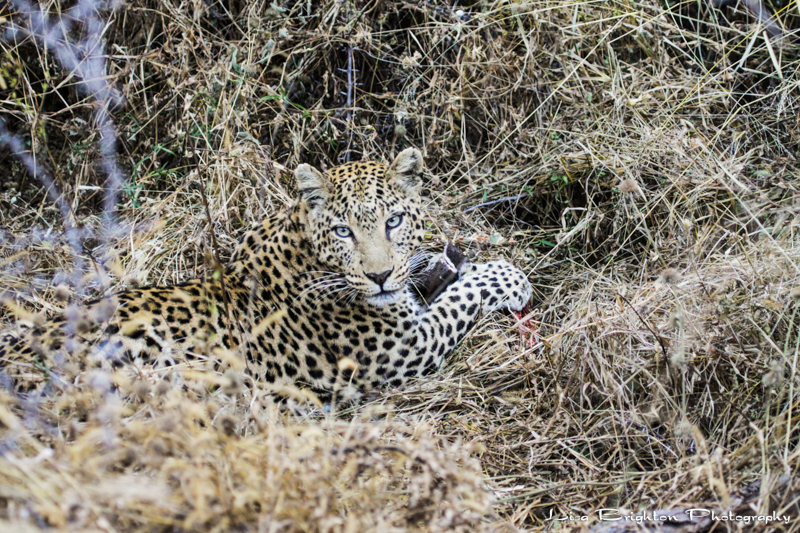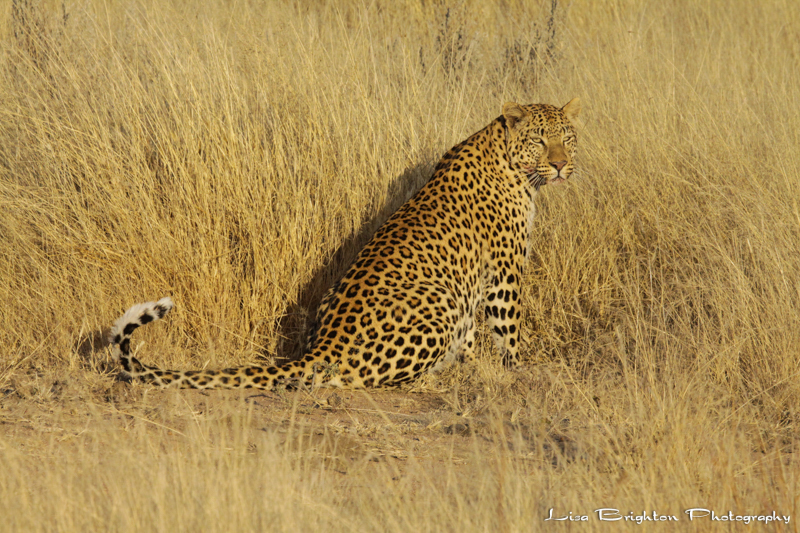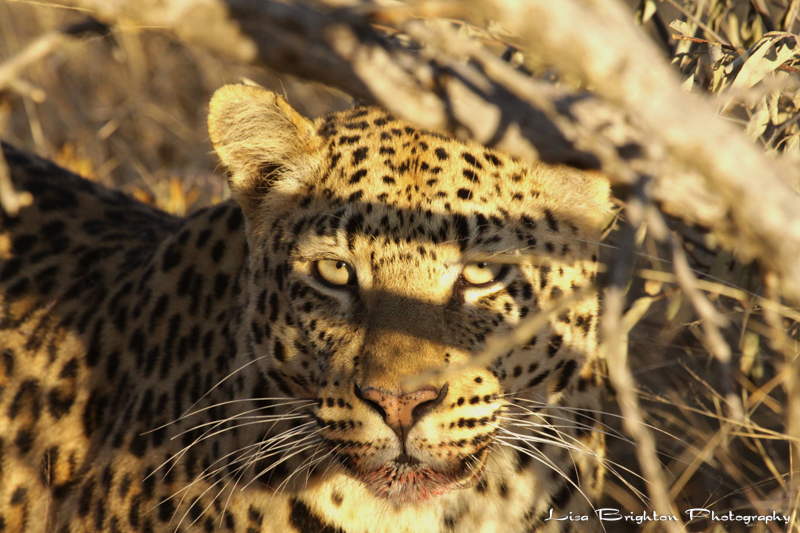8. Framed
 One virtue required on a safari in Africa is patience. Patience with the process of traveling all the way to a country like Namibia, which is at least two to three flights away from the United States. Patience with the physical effects of the time change, which depend on a traveler’s adaptability and sleep patterns. Last, and most important, patience with the process of game drives and the length of time it takes to spot an elusive cheetah, lion or leopard. Most safari-goers, including myself, want to see and photograph the cats, two of which are part of Africa’s traditional “Big 5” game animals. The elephant, rhino and buffalo are the other three. This morning we are in search of leopards in an area where one was recently spotted. Knowing this encourages our search, but considering how well-camouflaged they can be, we still have to be patient. Tarry, our driver and guide, rolls over the rough ground and plows through dense vegetation and grassland hoping to find one. With cameras at the ready, we dodge tree branches and thorny bushes and work to spot one either perched in a tree, lying in the grass or prowling on the hunt for breakfast. It is meal time after all. I never saw a “kill” on the two previous safaris I went on, so I’m not quite sure how I feel about seeing one. But I know it’s a possibility at any point on this journey. Animals eat when they’re hungry. Period. Seeing one in pursuit of nourishment is bound to happen either this morning, later today or tomorrow — or maybe not at all, which would be fine with me. As this thought lingers, we continue searching. I suddenly hear Tarry say
One virtue required on a safari in Africa is patience. Patience with the process of traveling all the way to a country like Namibia, which is at least two to three flights away from the United States. Patience with the physical effects of the time change, which depend on a traveler’s adaptability and sleep patterns. Last, and most important, patience with the process of game drives and the length of time it takes to spot an elusive cheetah, lion or leopard. Most safari-goers, including myself, want to see and photograph the cats, two of which are part of Africa’s traditional “Big 5” game animals. The elephant, rhino and buffalo are the other three. This morning we are in search of leopards in an area where one was recently spotted. Knowing this encourages our search, but considering how well-camouflaged they can be, we still have to be patient. Tarry, our driver and guide, rolls over the rough ground and plows through dense vegetation and grassland hoping to find one. With cameras at the ready, we dodge tree branches and thorny bushes and work to spot one either perched in a tree, lying in the grass or prowling on the hunt for breakfast. It is meal time after all. I never saw a “kill” on the two previous safaris I went on, so I’m not quite sure how I feel about seeing one. But I know it’s a possibility at any point on this journey. Animals eat when they’re hungry. Period. Seeing one in pursuit of nourishment is bound to happen either this morning, later today or tomorrow — or maybe not at all, which would be fine with me. As this thought lingers, we continue searching. I suddenly hear Tarry say , “There’s a leopard! On the right side of the Jeep.” I look in that direction, but I can’t see it. I intensely search the grass on the right side of the vehicle. As Tarry inches closer to where he says it is, I slide as close to the right side of the seat as I can, panning the grass until the leopard comes into view. Wow… It’s really close… Too close… I slide back to the left a little bit, allowing myself to move back into my comfort zone. I put my camera to my eye and take a few images, and then I notice that it’s eating something. “Looks like it’s just killed a small deer,” Tarry says. I zoom in and see a tiny part of something under the leopard’s right paw, but I can’t tell what it is. “A deer?” I whisper. “Yes. A dik-dik,” Tarry says. “They are very small. About a foot tall.” I’ve never seen this species of deer, so I stay zoomed in on the leopard, waiting for her to turn and look into my lens. She finally does. Click. I take the image. As quickly as I take the shot, the cat stands up and swiftly moves into a wooded area. Tarry cautiously turns the Jeep around, hoping the leopard will eventually walk through and continue to a clearing on our right — and she does. The leopard emerges and sits in the tall golden grass, soaking up the warm morning sun with her full belly in view. She briefly looks in our direction before she starts walking again. We continue following her at close range until she stops. Then we stop. We’re stalking her, and she knows it. I sit and patiently wait with my lens pointed in her direction until she looks directly into my lens. I gasp. She is staring at me with the sun illuminating her eyes, framed between the shade of two tree branches. The intense exchange thrills me. It almost distracts me from the blood on her chin…
, “There’s a leopard! On the right side of the Jeep.” I look in that direction, but I can’t see it. I intensely search the grass on the right side of the vehicle. As Tarry inches closer to where he says it is, I slide as close to the right side of the seat as I can, panning the grass until the leopard comes into view. Wow… It’s really close… Too close… I slide back to the left a little bit, allowing myself to move back into my comfort zone. I put my camera to my eye and take a few images, and then I notice that it’s eating something. “Looks like it’s just killed a small deer,” Tarry says. I zoom in and see a tiny part of something under the leopard’s right paw, but I can’t tell what it is. “A deer?” I whisper. “Yes. A dik-dik,” Tarry says. “They are very small. About a foot tall.” I’ve never seen this species of deer, so I stay zoomed in on the leopard, waiting for her to turn and look into my lens. She finally does. Click. I take the image. As quickly as I take the shot, the cat stands up and swiftly moves into a wooded area. Tarry cautiously turns the Jeep around, hoping the leopard will eventually walk through and continue to a clearing on our right — and she does. The leopard emerges and sits in the tall golden grass, soaking up the warm morning sun with her full belly in view. She briefly looks in our direction before she starts walking again. We continue following her at close range until she stops. Then we stop. We’re stalking her, and she knows it. I sit and patiently wait with my lens pointed in her direction until she looks directly into my lens. I gasp. She is staring at me with the sun illuminating her eyes, framed between the shade of two tree branches. The intense exchange thrills me. It almost distracts me from the blood on her chin… 
